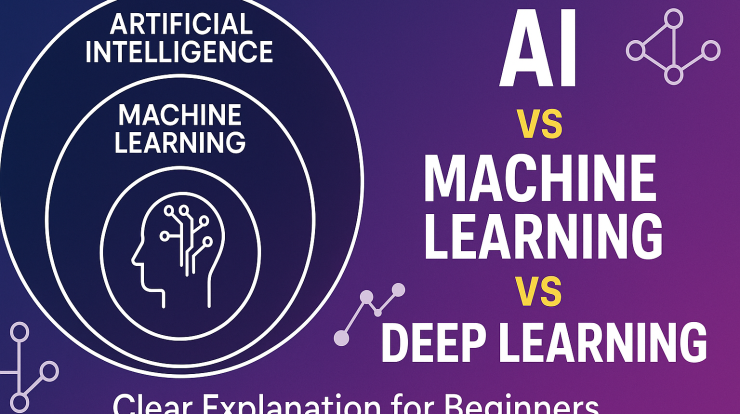Machine Learning (ML) is one of the fastest-growing technologies in the world today. Almost every digital service we use—from Google Search, TikTok, online shopping platforms, to mobile camera apps—relies on ML to deliver smarter, more personalized experiences.
In this article, we’ll explore Machine Learning in simple language, understand how it works, what it is used for, and the tools you need to get started.
What Is Machine Learning?
Machine Learning is a method that enables computers to learn patterns from data without being explicitly programmed.
In traditional programming, we give the computer:
- Rules
- Data
And the computer provides an output.
But in Machine Learning, we give the computer:
- Data
- The correct answers (labels)
And the computer learns the rules on its own.
A simple example
Imagine you want a computer to identify whether a picture contains a cat.
With Machine Learning, you only need to provide:
- Lots of cat images (labeled cat)
- Lots of non-cat images (labeled not cat)
The ML model will learn the patterns that distinguish a cat—ear shape, fur texture, facial features, and more.
Why Is Machine Learning Important?
Today, the world produces more data than humans could ever analyze manually. Machine Learning helps us:
- Make automatic decisions
- Predict future outcomes
- Discover hidden patterns
- Improve operational efficiency
This is why ML is widely used across industries: healthcare, finance, education, logistics, agriculture, entertainment, and more.
Main Types of Machine Learning
There are three major categories of ML that beginners should know.
1. Supervised Learning
The model learns using labeled data (data with correct answers).
Examples:
- Predicting house prices
- Classifying images
- Detecting spam emails
Popular algorithms:
- Linear Regression
- Logistic Regression
- Random Forest
- Support Vector Machine
2. Unsupervised Learning
The model learns from unlabeled data to find hidden patterns.
Examples:
- Grouping customers by behavior
- Detecting anomalies
- Market segmentation
Common methods:
- K-Means Clustering
- PCA (Principal Component Analysis)
3. Reinforcement Learning
The model learns through trial and error using rewards and penalties—similar to how humans learn.
Examples:
- Robotics
- Game-playing AI (Chess, Go, Dota 2)
- Self-driving cars
Real-World Examples of Machine Learning
Even if you don’t realize it, you interact with Machine Learning every day.
1. Product and Content Recommendations
Platforms like TikTok, YouTube, Netflix, and Amazon use ML to predict what you want to see next.
2. Face Recognition on Smartphones
Unlocking your phone with your face uses a deep learning model.
3. Spam Email Detection
Your inbox stays clean thanks to ML classification algorithms.
4. Navigation Apps (Google Maps, Waze, Grab)
ML predicts traffic, travel time, and optimal routes.
5. Medical Diagnosis
ML models help detect diseases from X-rays, MRIs, and medical images.
Tools Beginners Need to Learn Machine Learning
You don’t need a super-powerful computer to start learning ML. Here are the essential tools:
1. Python
The most popular programming language for ML.
2. Jupyter Notebook
An interactive coding environment ideal for experiments.
3. Google Colab
A free cloud-based notebook with GPU support—perfect for beginners.
4. ML Libraries
- NumPy (numerical operations)
- Pandas (data manipulation)
- Matplotlib (visualization)
- Scikit-learn (classical ML algorithms)
- TensorFlow / PyTorch (deep learning)
How to Start Learning Machine Learning
Here’s the best path for beginners:
- Learn basic Python
- Learn data processing (NumPy, Pandas)
- Understand basic ML concepts: dataset, features, labels
- Study simple algorithms first (regression, classification)
- Build small projects
- Move on to Deep Learning
Machine Learning is best learned by doing—not just reading.
Conclusion
Machine Learning is a technology that allows computers to learn from data and make decisions automatically. It is essential in today’s digital era due to the massive amount of information we generate daily. With the right understanding and tools, anyone—including beginners—can start learning Machine Learning.

